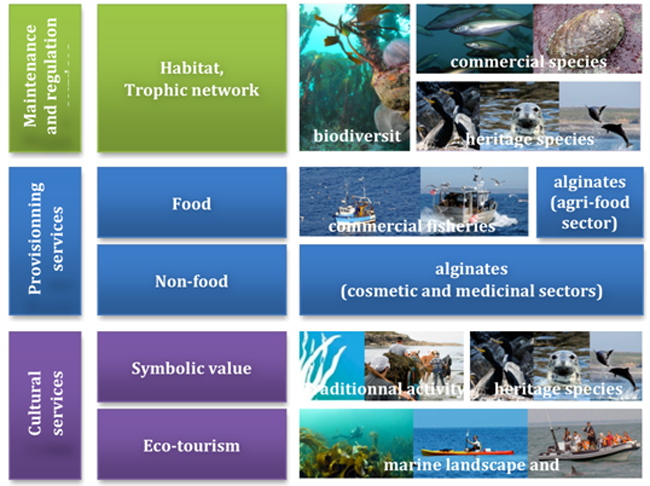5.5.5 Parc Naturel Marin d'Iroise: Ecosystem Services Assessment Methods

From an ecosystem services perspective, kelp ecosystems are used for alginate production but they also deliver many other services due to their bio-physical richness, their biodiversity and their contribution to the cultural heritage of the area. The management plan for the sustainable exploitation of kelp resources has been selected as the topic that could be usefully re-examined using the ecosystem services approach. This issue needs a more integrated approach as it is connected to other management objectives, especially the conservation of habitats and species, and the protection and promotion of maritime heritage.
The topic identified for study in the Parc Naturel Marin d'Iroise was the ecosystem services provided by kelp forest habitats.
The identification of ecosystem services provided by the Iroise kelp ecosystem was carried out by experts (managers, ecologists and economists) on a consensus-based approach during the Triage process.
In order to capture the social perception of kelp ecosystem services, the team relied mainly on the outcomes of discussions of the dedicated commission of the Regional Fisheries Committee (CRPMEM). The representations of the kelp socio-ecosystem and scenarios definition were completed by interviews with key stakeholders and meetings of scientific experts for the Iroise and managers of the French Marine Protected Areas Agency.
A detailed specification of kelp ecosystem services was built during workshops and focus-groups meetings with scientists and stakeholders. Following VALMER project recommendations for operational Ecosystem Services Assessment [Mongruel et al., 2015], a systematic review of scientific knowledge of kelp ecosystems was prepared and at the same time a synthesis of human activities and social demand for kelp exploitation and conservation to give a list of potential kelp related ecological functions and ecosystem services.
The initial list encompassed up to 30 ecosystem services and was then reduced to 9 ecosystem services, which would be of interest for assessment, according to the Triage approach ![]() [Pendleton et al., 2014].
[Pendleton et al., 2014].
 Figure: Ecosystem services selected from the TRIAGE approach
Figure: Ecosystem services selected from the TRIAGE approach
Considering the aim of the ecosystem services assessment and the numerous factors of influence, which must be taken into account, a dynamic system model for simulating the impacts of various fisheries management options (on four or five key ecosystem services) appeared to be the best approach.
The first step was to build a conceptual model of kelp ecosystems, the functions they support for biodiversity and human activities and the governance system for the management of the whole ecosystem and resources.
A numeric simulation model was built starting with the ecological component and followed by an integrated simulation to model the bio-economic aspect of the kelp fishery, which is the core of the system model. It allows the predictive simulation of the influence of the management options on the ecological functions of the kelp fields for commercial and heritage species.
At the same time, a study was conducted on the impact of different algae harvesting techniques (combs, scoubidous) and it included: monitoring the survival of damaged algae, releases, habitat modifications, new hires, etc. This knowledge was completed by a scientific monitoring of the kelp population. Such data feed the modelling of the harvesting activity impact on the kelp population and enable the development of the kelp population dynamics model.
The simulation model of the kelp social-ecosystem was used to estimate a range of indicators that corresponded to the ecosystem services identified of the kelp forests of the Molène archipelago. This multi-criteria analysis grid was used to compare the impacts of scenarios on the ecosystem services.

